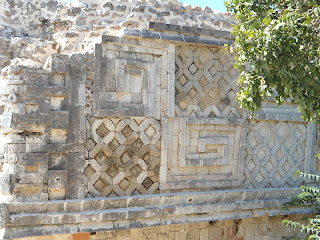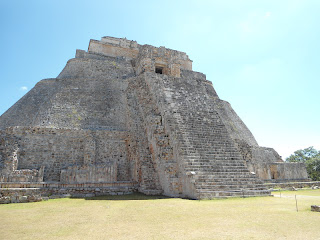Uxmal is located in the Santa Elena Valley to the south of the Puuc hill country in the southwestern part of the Yucatan Peninsula. The zone was first settled in 500 B.C., but it wasn't until the ninth and twelfth centuries A.D. that it became the seat of Mayan political and economic power in the Puuc region.
It is estimated that a population of around 25000 inhabitants was distributed throughout a territory of 37.5 square kilometers with enormous agricultural potential, but lacking of permanent water sources. For this reason the Maya constructed chultunes, or underground cisterns, and a complex drinking water system, including aguadas and bukteoobob for the utilization of rainwater.
The architecture at this site is one of the most authentic examples of the Puuc style. Decorative features such as the three-dimensional masks of the god Chaac, colonnades, the two-headed jaguar and other iconographic symbols demonstrate Uxmal's position in the most important cultural and commercial circuits of the Maya classic era.
The walled civic-administrative area occupies an area of one kilometer from north to south and 6 kilometer from east to west. The palace-type structures are arranged around courtyards, forming quadrangles. The decoration is among the richest and most varied of all the archaeological zones, including representations of gods, animals, dignitaries and geometric forms. There are also residential structures in the surrounding area.
I just have to say that it was a beautiful site and I really enjoyed it.
It is estimated that a population of around 25000 inhabitants was distributed throughout a territory of 37.5 square kilometers with enormous agricultural potential, but lacking of permanent water sources. For this reason the Maya constructed chultunes, or underground cisterns, and a complex drinking water system, including aguadas and bukteoobob for the utilization of rainwater.
The architecture at this site is one of the most authentic examples of the Puuc style. Decorative features such as the three-dimensional masks of the god Chaac, colonnades, the two-headed jaguar and other iconographic symbols demonstrate Uxmal's position in the most important cultural and commercial circuits of the Maya classic era.
The walled civic-administrative area occupies an area of one kilometer from north to south and 6 kilometer from east to west. The palace-type structures are arranged around courtyards, forming quadrangles. The decoration is among the richest and most varied of all the archaeological zones, including representations of gods, animals, dignitaries and geometric forms. There are also residential structures in the surrounding area.
I just have to say that it was a beautiful site and I really enjoyed it.













































No comments:
Post a Comment